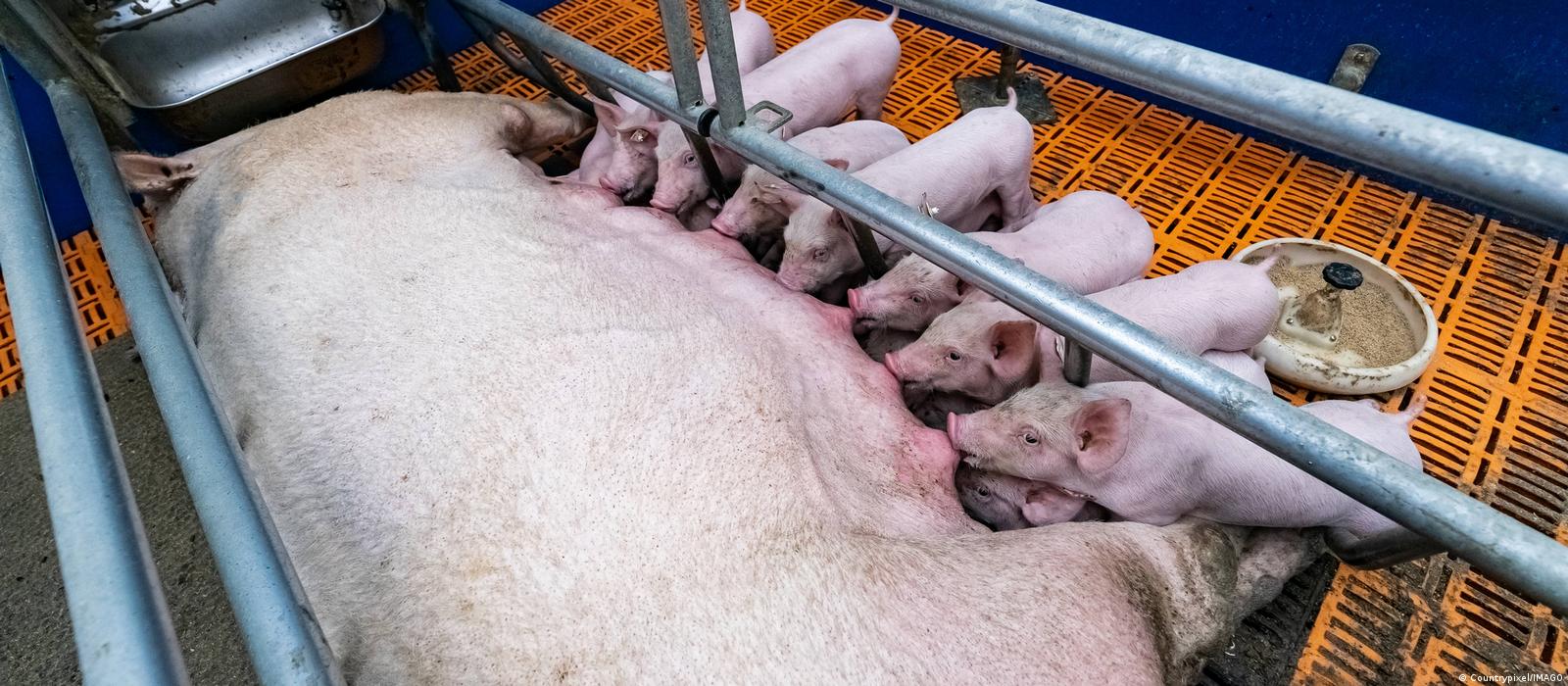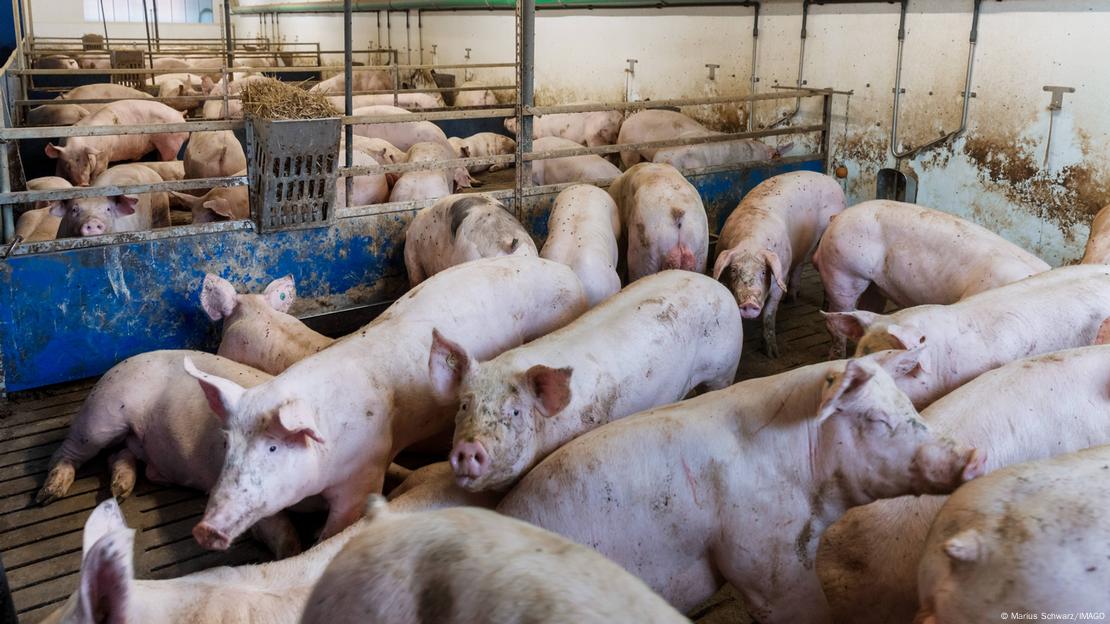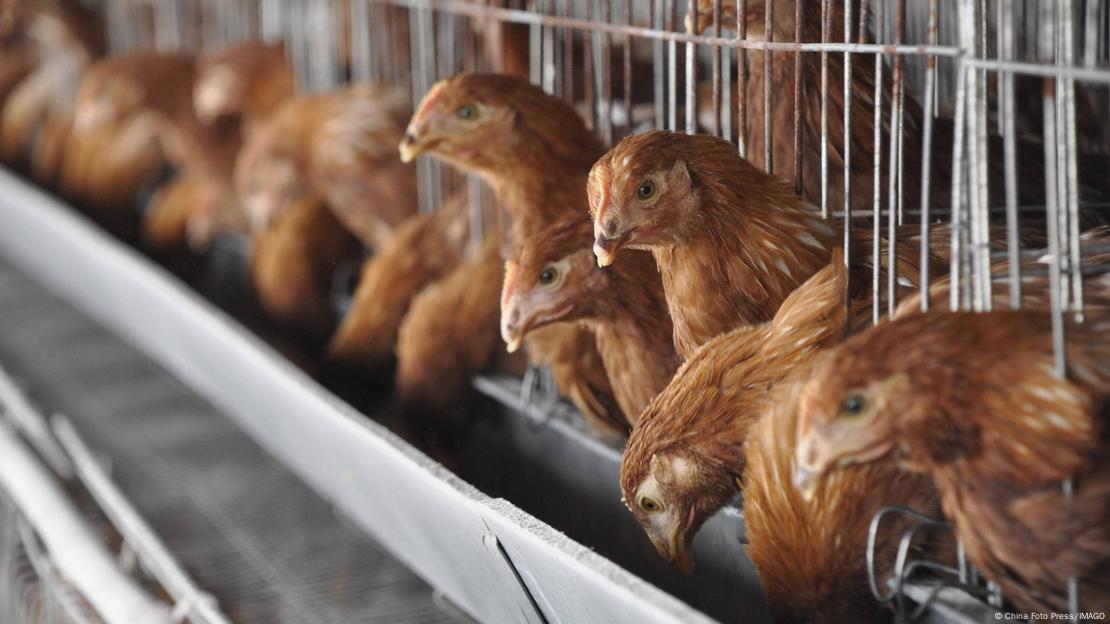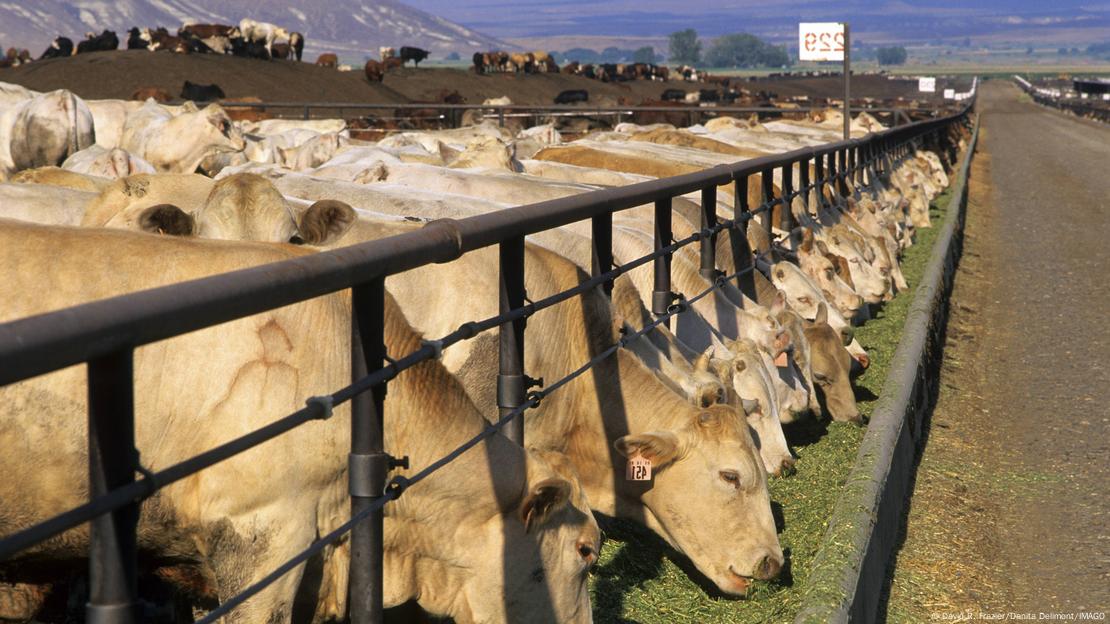Despite demands for improved farmed animal welfare, livestock is reared in confinement and isolation as intensive factory production also compounds pollution.

Stuart Braun
DW
03/16/2023
03/16/2023
March 16, 2023
The global production of animal flesh for human consumption was 45% higher in 2020 than in 2000 as the global taste for meat skyrockets.
The carnal boom is being fed through increased farming intensity, with animals such as chicken and pigs kept in smaller, more restrictive spaces such as cages, pens and stalls.
Though in the European Union, 94% of citizens are concerned for the welfare of farmed animals — and near 60% are prepared to pay more animal welfare-friendly meat production — the caging of hens, pigs or rabbits remains widespread.
Welfare concerns extend to the environment. For one, animal meat production is bad for the climate, producing 14.5% of all greenhouse gas emissions — roughly equivalent to the entire global transport sector, according to Greenpeace.
Nitrogen-rich feed given to meat-producing animals also produces manure high in toxic ammonia, which in turn produces the potent greenhouse gas, nitrogen oxide. Ammonia impacts animal welfare by damaging the eyes and respiratory systems of battery hens, for example.
Animal rights activists argue that humane livestock farming — including free range egg laying hens — can reduce feed, fuel and water needs, cutting costs and pollution by also recycling nutrients and improving soil.
But campaigners ultimately agree that reducing meat consumption and production is the ultimate way to minimize the welfare and environmental impacts of meat.
As the opposite happens, how are farmed animals being treated around the world, and how might their welfare be improved?
The global production of animal flesh for human consumption was 45% higher in 2020 than in 2000 as the global taste for meat skyrockets.
The carnal boom is being fed through increased farming intensity, with animals such as chicken and pigs kept in smaller, more restrictive spaces such as cages, pens and stalls.
Though in the European Union, 94% of citizens are concerned for the welfare of farmed animals — and near 60% are prepared to pay more animal welfare-friendly meat production — the caging of hens, pigs or rabbits remains widespread.
Welfare concerns extend to the environment. For one, animal meat production is bad for the climate, producing 14.5% of all greenhouse gas emissions — roughly equivalent to the entire global transport sector, according to Greenpeace.
Nitrogen-rich feed given to meat-producing animals also produces manure high in toxic ammonia, which in turn produces the potent greenhouse gas, nitrogen oxide. Ammonia impacts animal welfare by damaging the eyes and respiratory systems of battery hens, for example.
Animal rights activists argue that humane livestock farming — including free range egg laying hens — can reduce feed, fuel and water needs, cutting costs and pollution by also recycling nutrients and improving soil.
But campaigners ultimately agree that reducing meat consumption and production is the ultimate way to minimize the welfare and environmental impacts of meat.
As the opposite happens, how are farmed animals being treated around the world, and how might their welfare be improved?
In 2021, the European Parliament overwhelmingly committed to prohibiting the caging of farmed animals.
A subsequent law being drafted by the European Commission will release all hens, mother pigs, calves, rabbits, ducks, geese and other farmed animals from cages across Europe by 2027.
The law was inspired by a citizen's initiative in the EU to "End the Cage Age" that garnered 1.4 million signatures and aims to end the pain and trauma for over 300 million animals who spent all or part of their lives in cages, pens or stalls.
This goal has almost been reached by several EU countries: Luxembourg, Austria, Sweden, the Netherlands and Germany are between 98% and 87% cage-free.
In Spain, by contrast, more than 86 million animals are farmed in cages, with only 13% of livestock unconfined.
With most EU countries having a cage-free rate under 40%, including France (34%) and Greece (22%), freeing factory farmed animals across the region in the next few years seems unlikely.

Some pigs spend their entire lives inside
Image: Marius Schwarz/IMAGO
Across the bloc, nearly all adult female pigs who experts say are highly intelligent and crave outdoor space, spend around half the year inside "gestation crates" in which they can barely move — let alone turn around.
According to the US-based animal rights group, The Humane League, these sows are exploited as breeding machines that continually produce piglets in cold, dark, dirty pens where they often succumb to sickness. They "are among the most abused animals on the planet," state the group.
In China, the construction of a 26-story pig farm skyscraper rearing 1.2 million animals annually in Hubei province is also raising both ethical concerns and fears that it will become a breeding ground for zoonotic diseases.
Meanwhile, draft legislation passed in October in Germany will allow consumers to choose products using more humane production methods. All pork products, for example, will be legally required to have a label that differentiates between five different methods of rearing: barn pen; barn pen and extra space; open-air barn pen; run and open land; and organic.
Yet animals raised on organic farms are not immune from suffering. One German study shows that more than half of dairy cows in organic farms have mastitis, a painful inflammation of the udder, yet are still milked daily. While mastitis is also common in conventional farms, organic production standards prohibit antibiotics and hence limit effective treatment in organic cows.
A report by German-based consumer watchdog Foodwatch shows that organically farmed pigs — where animals are given straw and more space, for example — suffer from pneumonia, open wounds and abscesses at almost the same rate as in conventional farms due to failure to monitor livestock health.
Feeding our chicken addiction
While the European Union is one region trying to encourage cage-free farming, around 33.1 billion chickens were farmed globally in 2020 — more than five for every human on the planet.
This represents a 130% rise in 20 years, illustrating the scale of the quest to feed the growing lust for animal flesh through ethical, low-intensity methods.
Across the bloc, nearly all adult female pigs who experts say are highly intelligent and crave outdoor space, spend around half the year inside "gestation crates" in which they can barely move — let alone turn around.
According to the US-based animal rights group, The Humane League, these sows are exploited as breeding machines that continually produce piglets in cold, dark, dirty pens where they often succumb to sickness. They "are among the most abused animals on the planet," state the group.
In China, the construction of a 26-story pig farm skyscraper rearing 1.2 million animals annually in Hubei province is also raising both ethical concerns and fears that it will become a breeding ground for zoonotic diseases.
Meanwhile, draft legislation passed in October in Germany will allow consumers to choose products using more humane production methods. All pork products, for example, will be legally required to have a label that differentiates between five different methods of rearing: barn pen; barn pen and extra space; open-air barn pen; run and open land; and organic.
Yet animals raised on organic farms are not immune from suffering. One German study shows that more than half of dairy cows in organic farms have mastitis, a painful inflammation of the udder, yet are still milked daily. While mastitis is also common in conventional farms, organic production standards prohibit antibiotics and hence limit effective treatment in organic cows.
A report by German-based consumer watchdog Foodwatch shows that organically farmed pigs — where animals are given straw and more space, for example — suffer from pneumonia, open wounds and abscesses at almost the same rate as in conventional farms due to failure to monitor livestock health.
Feeding our chicken addiction
While the European Union is one region trying to encourage cage-free farming, around 33.1 billion chickens were farmed globally in 2020 — more than five for every human on the planet.
This represents a 130% rise in 20 years, illustrating the scale of the quest to feed the growing lust for animal flesh through ethical, low-intensity methods.

Chickens raised for both meat and egg production (pictured) are often kept in sprawling factory farms
China Foto Press/IMAGO
Back in the US, broiler chickens that are farmed for their meat constitute 95% percent of the animals slaughtered worldwide each year for food, note the California-based Factory Farming Awareness Coalition. The US is the world's number one chicken meat producer.
Broiler chickens are typically raised with 20,000 other birds in a 16,000 square foot (1,486 square meters) shed, which equals around three-quarters of a square-foot for each bird.
Amid this overcrowding, chickens are grown to full size and slaughtered within six weeks. Poultry in the 1950s reached the same weight in around triple the time, according to Compassion in World Farming.
Due to the rapid growth of birds bred for their oversized appetites, their legs cannot support their body weight, forcing them to lie on the floor while suffering pain and lameness. Organs like the heart and lungs are also put under strain, resulting in early death.
The confinement of cattle
While cows bred for beef globally are partly raised on pastures, they increasingly spend their final months in confined "landless" feedlots where they are typically fattened on a grain diet dominated by high-energy corn — as opposed to grass, their natural diet — before slaughter.

Cows are regularly kept in confined spaces without protection from the elements in the weeks before slaughter
Image: David R. Frazier/Danita Delimont/IMAGO
Feedlots have an average capacity of around 1,000 cows in the US, while in South Africa the largest lot holds 130,000 cattle, according to experts.
Cattle around the world — including calves who can spend their whole life in these lots — typically have little or no cover and endure cold, muddy conditions in the winter, or suffer heat stress during hot and dry summers in lots with no shade.
In Australia, one of the world's biggest beef exporters, there are some 500 of these feedlots that housed a record near 1.3 million cattle in 2022. According to the RSPCA animal welfare group in Australia, the lots' abrasive and muddy surfaces cause lameness, pain and lesions in the cattle due to an inflammatory disease affecting the hooves.
Nonetheless, the welfare of cattle in Australia confined to feedlots is making some progress, with over 90% of them now accredited under national animal welfare standards including the draining of muddy pens, hospital pens for sick cattle, and giving extra care to pregnant cows and new-born calves.
Proponents of the feedlot system argue it's a more sustainable way to produce meat as forests and other ecosystems are not converted to pasture. But experts also show how barley or corn diets in feedlots produce around 40% more emissions of methane, a potent greenhouse gas.
Edited by: Tamsin Walker
Feedlots have an average capacity of around 1,000 cows in the US, while in South Africa the largest lot holds 130,000 cattle, according to experts.
Cattle around the world — including calves who can spend their whole life in these lots — typically have little or no cover and endure cold, muddy conditions in the winter, or suffer heat stress during hot and dry summers in lots with no shade.
In Australia, one of the world's biggest beef exporters, there are some 500 of these feedlots that housed a record near 1.3 million cattle in 2022. According to the RSPCA animal welfare group in Australia, the lots' abrasive and muddy surfaces cause lameness, pain and lesions in the cattle due to an inflammatory disease affecting the hooves.
Nonetheless, the welfare of cattle in Australia confined to feedlots is making some progress, with over 90% of them now accredited under national animal welfare standards including the draining of muddy pens, hospital pens for sick cattle, and giving extra care to pregnant cows and new-born calves.
Proponents of the feedlot system argue it's a more sustainable way to produce meat as forests and other ecosystems are not converted to pasture. But experts also show how barley or corn diets in feedlots produce around 40% more emissions of methane, a potent greenhouse gas.
Edited by: Tamsin Walker
No comments:
Post a Comment